Gains o' clock
Click on the icons for a
look into a bodybuilder's life
More Than A Beauty Pageant
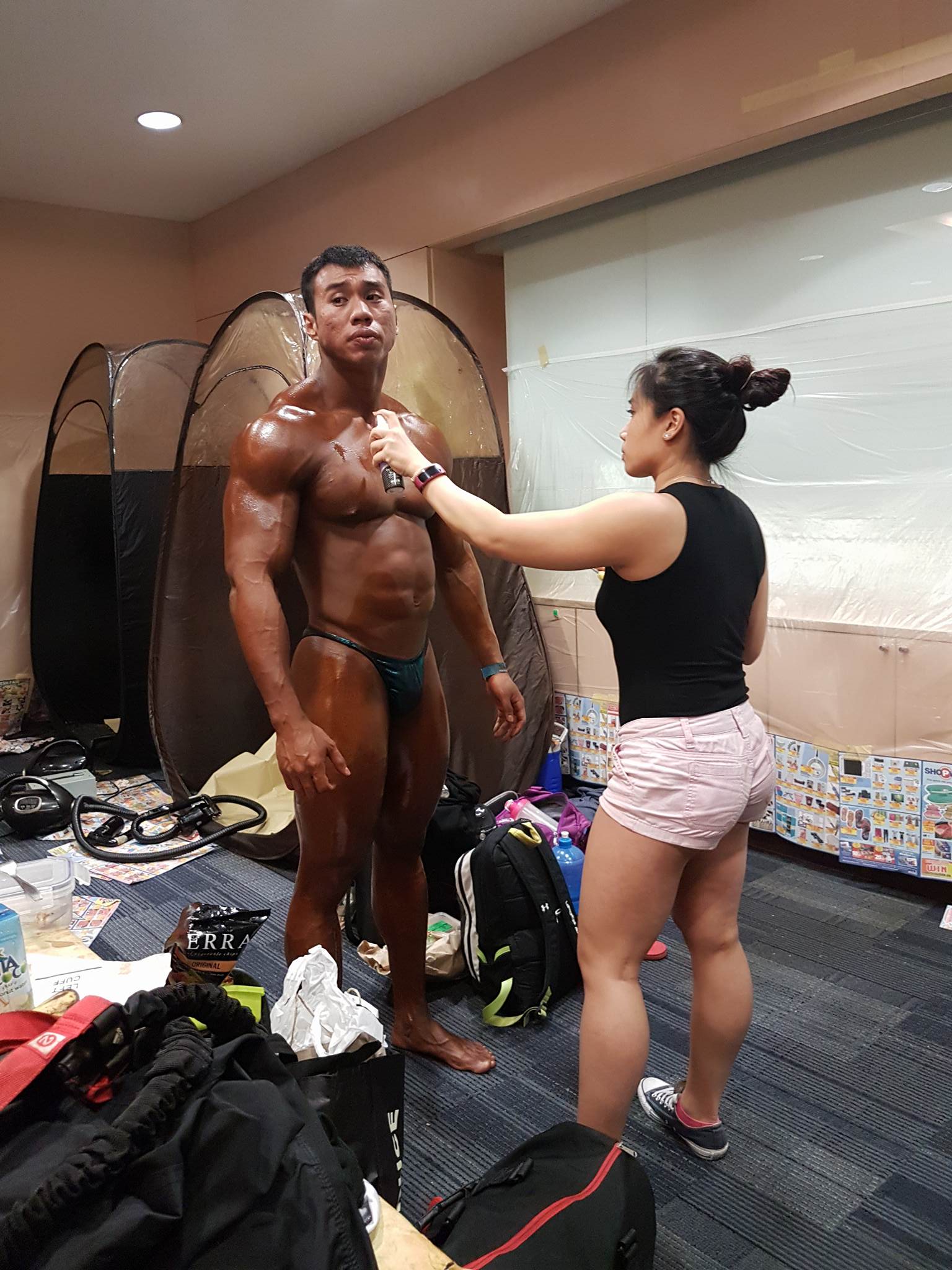
To dye for: Benjamin gets his final touch-up before taking the stage. PHOTO: BENJAMIN BROUGHTON
As their numbers are called, they step onstage one by one in tiny trunks and flex in front of a panel of judges. Standing among the other heavily oiled and bronzed men, 22-year-old Benjamin Broughton is trying his best not to collapse.
Bodybuilding competitions are often dubbed beauty pageants because contestants are judged on how aesthetically pleasing their bodies are. More specifically, the typical criteria are condition, which refers to how lean the body is, size and symmetry.
But few know the sheer torture that bodybuilders go through for three to four months just for five minutes on stage. Diets are extra strict and meals increase as they try to gain mass but reduce body fat. Typically, this means six to 12 clean meals a day at specific times.
Simultaneously, training intensity also increases. “I was getting four hours of sleep a day,” said Benjamin, who competed in the Junior divisionCompetition Categories:
Men's:
- Bodybuilding
- Physique: male model physique, less muscular than Bodybuilding
- Classic Bodybuilding: larger build than Physique but less extreme than Bodybuilding
Women's:
- Physique: most muscular
- Figure: less muscular, more streamlined
- Bikini: athletic, model-like physique
- Fitness: requires dance routines and athleticism
Most competitions are further split into smaller divisions, namely
- Master’s: 40 years and up
- Junior’s: 23 years and under
- Weight classes of the 2016 IFBB Arnold Classic Asia competition in Hong Kong. “I was doing seven hours of cardio the whole week, and training 10 to 12 times a week.”
Bodybuilders often say, “the worse you feel, the better you look.” For Benjamin, the week leading up to a competition, when he has to reduce water intake to look more conditioned, is the toughest. From the night before competition day until the results are out, not a drop of water passes his lips.
“Everyone is feeling like crap backstage, and nobody wants to talk, so you just sit there,” he said. “And when it’s time to go, you pretend to smile, and then you start posing – and posing is tough.” In Hong Kong during pre-judging, the first stage of the competition where competitors do a series of poses, Benjamin thought he was about to faint.
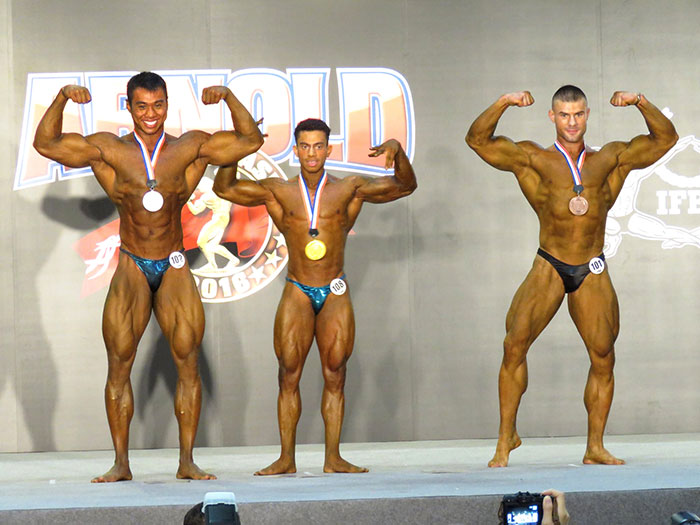
True grit: No pain betrayed by his megawatt smile. “My eyes were open but I couldn’t see anything because I was too dehydrated. But I knew my number, so when they called it I knew what pose to do. I could feel myself swaying but I was like, ‘OK you’ve got to hold. Hold the pose.’”PHOTO: BENJAMIN BROUGHTON
Afterwards, Benjamin was wheezing backstage and had trouble moving around. “It was so bad that when I walked around, my feet got blue-blacked because the padding on my feet was gone, so my bones were grinding the floor.”
But instead of stopping Benjamin from competing, the challenges of bodybuilding spur him on.
Despite the pain, Benjamin got back onstage for the final posing round, where contestants perform a series of rehearsed poses to the beat of their chosen song, and took home second place.
“If it were easy I wouldn’t do it,” said Benjamin, who is going back for the gold in Hong Kong this August. He likens bodybuilding to studying to get an A even though it’s “not fun”; or running a marathon even though it hurts. “It’s a love for competition, and being able to do something that someone else cannot, so you really have to push yourself.”
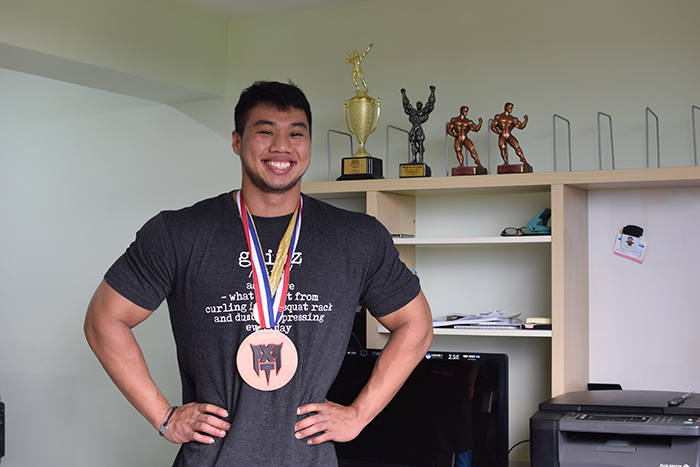
Last Men Standing: Not too sentimental about his medals and trophies, Benjamin keeps only a handful of “more important” ones.
Having only been competing since 2014, Benjamin is still working towards the coveted IFBB Pro CardSingapore's sole IFBB Pro Card holder Joan Liew only attained it after 17 years of competing.— the most prestigious and competitive one in the scene. Usually only given out to overall winners of certain national competitions or at the IFBB World Bodybuilding Championships, Pro Cards allow bodybuilders to compete professionally and for prize money.
At his next competition, Benjamin is entering the Men’s division for the first time. “Everyone’s 27 to 30 years old so they’re really huge already,” he said. “I’m one of the smallest.”
But as usual, Benjamin is up for the challenge. “I may not be the biggest right now, but I’m working harder than them so they’d better watch out.”
The Business of Fitness
Buying whole foods like chicken fillets, baby spinach and eggs for her clean diet sets Charis Liew back about $250 a month. The 24-year-old estimates she would save up to $100 if she just ate regular meals her mother cooks for the rest of the family. But after four years of bodybuilding, Charis prioritises her ideal body over dollars and cents.
“You can’t buy a well-built physique,” she said. “But you can buy more expensive food to get it.”
With necessities like large amounts of clean, whole foods, a gym membership and supplements like protein powder, maintaining muscle is not cheap. In order to continue working out, these bodybuilders have to also work – literally, often by setting up fitness-related businesses in personal training, online coaching, athletic wear or nutrition.
Food
$200- $350
Gym Membership
$60 - $80
Gym Clothes
$50 - $100
Supplements
$30 - $50
While Charis supports her lifestyle working a nine-to-five job at a recruitment firm, many other bodybuilders combine their lifestyle and work. Of the eight bodybuilders interviewed, five are personal trainers.
Since Benjamin Broughton, 22, was already clocking many hours in the gym, he figured the natural course of action would be to offer his expertise as a freelance personal trainer. Training six to eight clients a day, he makes enough to comfortably cover day-to-day bodybuilding expenses, but still feels the strain as a competitive bodybuilder.
It’s hard to make money as an amateur bodybuilder, said Benjamin. “In fact I ‘waste’ money bodybuilding,” he added, citing extra expenses like flights to overseas competitions, registration fees, accommodation and increased amounts of food.
His last competition in Hong Kong left a $3,000-sized hole in his pocket. Although Benjamin represents the SFBF, the local bodybuilding federation has no means to support athletes financially. “A tracksuit with the Singapore flag – that’s all I get from them,” he said.
And at the amateur level, there is no prize money to speak of. Despite placing second in his division at the Arnold Classics Asia in Hong Kong, Benjamin did not leave any richer.
To fund his dreams, he started an online clean food delivery service, Squeaky Clean Food. The business, which began operations last October, is a family venture with his mother and girlfriend of six years. Thrice a week, they cook and pack clean meals at home to deliver to customers, often working professionals, in the central business district. The business is doing well, with plans to expand to a central kitchen in the pipeline.
Whether as a hobby or a career, bodybuilding hasn’t proven financially viable yet. But in the meantime, for these young bodybuilders, getting to do what they love just about works out.
Eat Clean
Love At First Lift
Birds of a feather flock together – and apparently so do bodybuilders. As gyms are a common space for fitness enthusiasts to train together, it’s inevitable that sparks fly. We sat down with two couples to see if it was truly love at first lift.
Ian and Charis

Little did they know that two years and one heartbreak later, they would be formally introduced in Perth, at the Curtin University gym. “We actually had to have a mutual friend, an Australian, introduce two Singaporeans to each other,” grins Ian. “But in the back of our minds it’s like, aiya seen you before already. We all act blur only, like oh hi,” Charis adds, swatting him playfully.
Now, with Charis back in Singapore working full-time, and Ian in his second year of university, the couple has to deal with long-distance relationship woes. But in the time that Ian is home for the holidays, the two are quick to make full use of their time together. Their choice of date? The gym, of course.
“It’s good to have the same lifestyle – like going to the gym is a date,” says Ian. “You don’t have to go out of the way just to meet. If after a busy day we just want to get a workout in, that in itself is already our–”
“Our spending time with each other,” she finishes.
Ben and Min
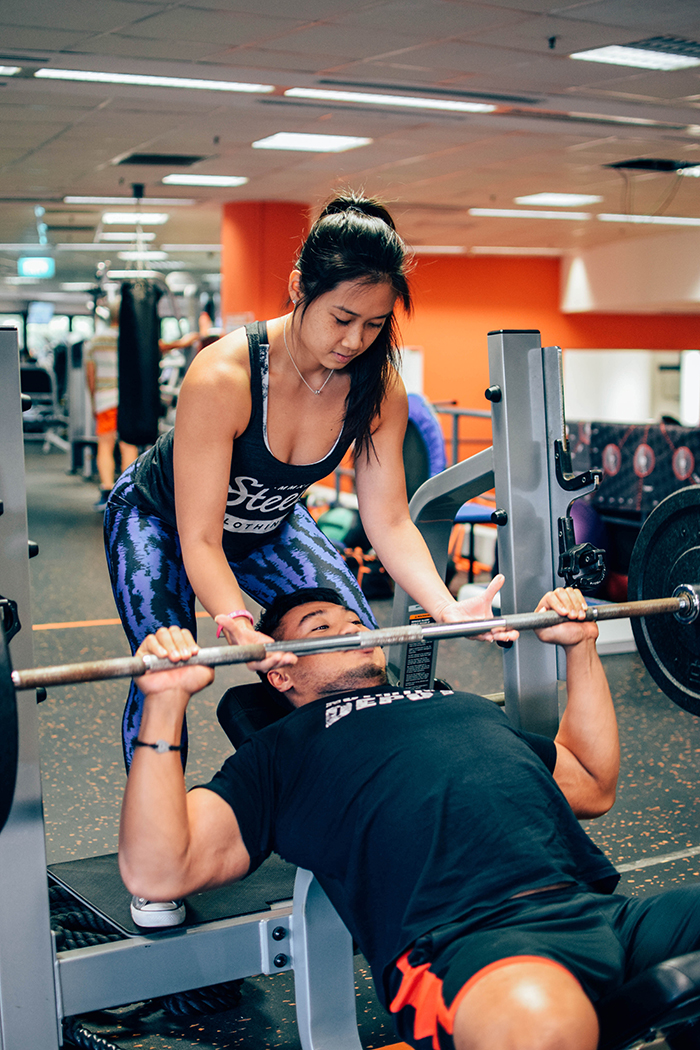
You know you’ve found The One when she’s willing to shave your back, then spray you with fake tan.
Being a “bodybuilder’s girlfriend” is more hectic than it sounds. Apart from good old love and support, Yu Huimin’s duties include following amateur bodybuilder Benjamin Broughton abroad when he competes internationally, and spraying him with three coats of fake tan.
“We usually bring our own spray can, just in case,” she explains. “If he needs to go to the toilet, it will smudge his legs – so I have to oil or tan him again.”
It’s a title she wears with pride, having watched Ben’s tremendous growth (literally, too) in the six years the couple, both 22, has been together. In fact, his constant trips to the gym were what pushed her to start picking up the weights too in 2013. And between daily workouts and running a new food delivery business together, the pair are inseparable.
“Min manages my life as I focus on my prep – she basically takes care of everything for me, taking care of me; when all I do is follow the diet and go to the gym,” says Ben, whose next competition is the Arnold Classic Asia in Hong Kong this September.
“It's easy to give up when you are competing for yourself, but winning for her is bigger than any reason to quit. A girlfriend who can still love you through prep will most probably be a wife that can love you through all of life.”
Roided Out
The myth goes like this: an Asian cannot achieve a classic bodybuilder’s physique without the help of steroids.
Hence the prevalence of drug use in the competitive bodybuilding industry – where, if one successfully skirts around official drug tests, seasoned judges close an eye. “For a professional competition, a lot of them use it; it’s a known fact,” said an ex-national bodybuilder who wanted to be known only as Geraint.
Professor Yang Yifan would like to be the first to debunk that myth. According to the assistant professor of the Physical Education and Sports Science department at the National Institute of Education, it is very much possible for an Asian physique to reach that of a typical bodybuilder organically – all it takes is hard work.
Training and diet are the most important aspects, said the 42-year-old. “No amount of drugs can make up for that,” she added.
So why the return to performance-enhancing drugs time and again? For one, the physical help it renders is undeniable. Anabolic steroids, the most commonly used drugs in bodybuilding, directly generate more muscle mass in the body. They also increase strength and endurance, so the body can train harder, with shorter breaks, and be less easily fatigued.
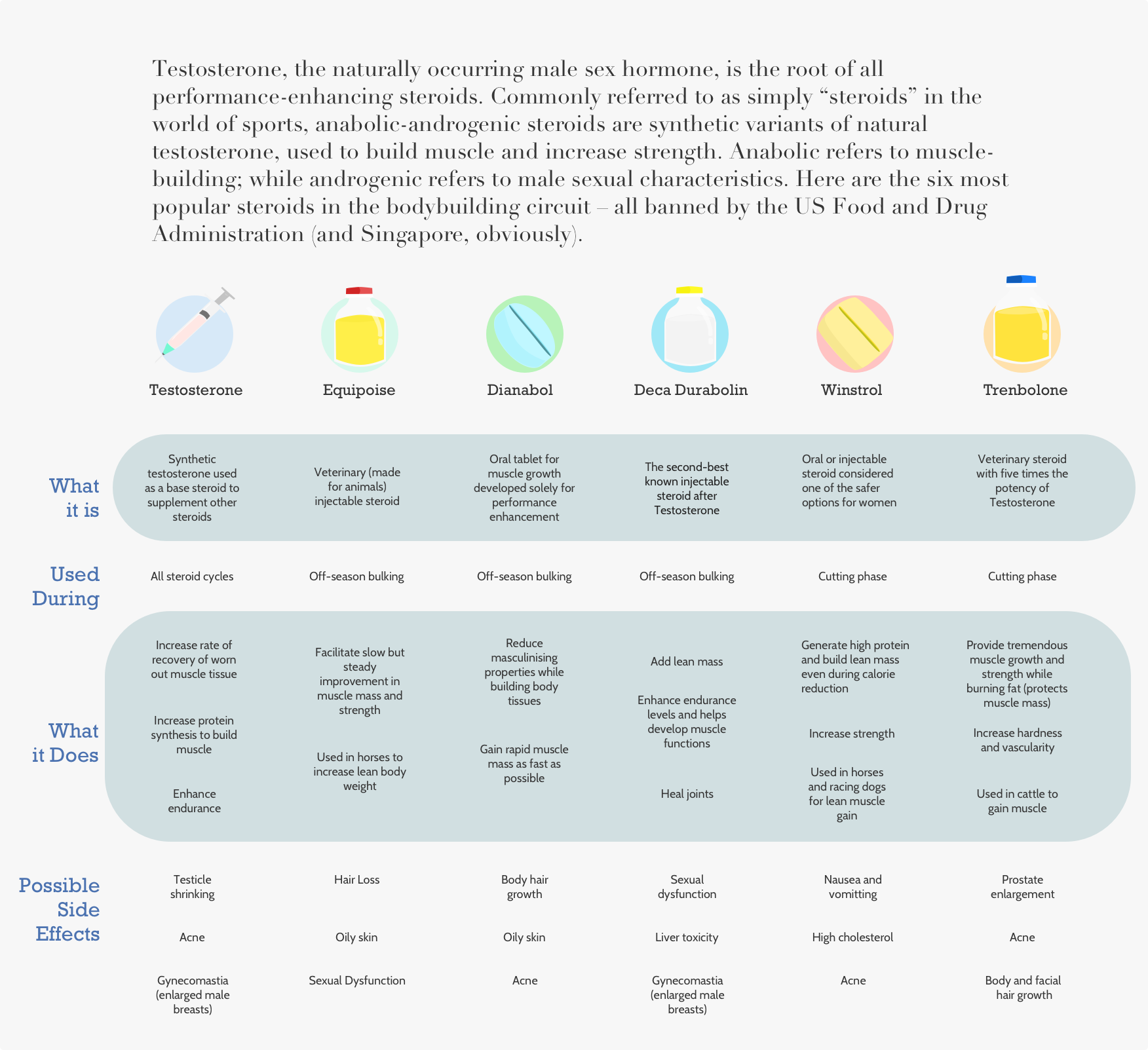
In addition, professional bodybuilders interviewed admitted that at the competitive level, an unspoken understanding that everybody takes steroids pushes them to follow suit.
Locally, under the Poisons Act, anyone convicted of the use of anabolic steroids and performance-enhancing drugs is liable for a fine of up to $10,000 and/or imprisonment for up to two years. In 2012, seven local bodybuilders tested positive, and were banned from competing for two years.
Prof Yang also warned of the multitude of side effects. Females, in particular, are susceptible to hormonal changes caused by anabolic steroids, such as disruption in menstrual cycles and developing male features. “The key thing is: Is it safe and is there going to be an unfair advantage if we take it?” she said.
“And if I may add – only cowards do that. Because they do not have the courage to face up to the reality that they are not as good.”
Do You Even Lift?
How do you tell a bodybuilder apart from the average gym goer? By his workout routine, of course.
To most people, the days of the week range from Monday to Sunday. But for a bodybuilder, it’s usually Arms Day to Legs Day. Bodybuilders plan their workouts according to six muscle groups: arms, legs, chest, back, shoulders and abs – and usually focus on just one a day, so they can train muscles more specifically and at a higher intensity.
The aim of the game is to completely fatigue the muscle, so it’ll be stimulated to grow bigger. In a day’s workout, bodybuilders tend to do five or six exercises that target the same muscle group, but in slightly different ways.
Here’s what typically goes down on Back Day.
Low Cable Pulley Row
Starting off with the toughest exercise, the low cable pulley row trains the rhomboids, which are the two muscles on each side of the spine.
Bent-Over Barbell Row
The bent-over barbell row works the rhomboids as well as the latissimi dorsi, which is the large flat muscle on the outside of the rhomboids - more commonly known as lats, or more commonly known among bodybuilders as lats.
Close-Grip Pull Down
Most bodybuilders want wider lats, which they often call ‘wings’. The close- grip pull down helps to form these wings, working muscles from the lower lats all the way into the spine.
Bent-Over Dumbbell Row
Similar to the bent-over barbell row, the bent-over dumbbell row targets the lats, but requires more stability for both arms to lift in unison.
Machine Row
The last exercise, the machine row, ensures no back muscle is left untouched at the end of the workout.
Weighing #fitspo
Are #fitspo selfies doing more harm than good?
Never underestimate the power of the 21st century hashtag. And especially #fitspo, which has taken root in the everyday millennial’s language – even though it only originated on Instagram around 2012.
Today, the term, a combination of ‘fit’ and ‘inspiration’, refers to an online community of fitness enthusiasts who encourage working out and a healthy lifestyle. Their content ranges from curated snaps of “clean” food, to “gym selfies” and body progress shots.
But while the simultaneous fitness and Instagram boom is no coincidence, the visual nature of bodybuilding has raised concerns. Just how healthy can a motivational health movement founded on comparing bodies be?
As a personal trainer and fitness guru, 26-year-old Kelyn Lau (@kelynlau) quickly amassed a following of 8.3k on Instagram, sharing inspirational posts on how her body progressed through training since she started in 2013. While she’s pleased that younger girls have contacted her through the channel to learn more about fitness, Kelyn warns that using only social media as a benchmark for comparison can become toxic.
Kelyn, whose clients are women ranging from 18 to mid-30s, admitted some had told her they were taking pills as shortcuts to achieve the ideal bodies they saw on their social media feeds.
“They want to slim down and get their ideal abs so badly that they’re not looking at their body and the person’s body online, and seeing that they are totally different,” she said.
Leisure bodybuilder Charis Liew (@charistigerlily), 24, agreed that it can be easy to succumb to making comparisons with shapelier bodies on social media, particularly for women. Recognising that every body responds differently to training is crucial for healthy progress, she added.
“Comparing is not a bad thing – but it should never be that you are comparing your own progress with somebody else’s,” added Charis.
And to some serious bodybuilders, using Instagram as a platform to promote fitness has also diluted the essence of the sport.
Two-time Mr. Singapore Adrian Tan (@official_adriantan), 42, said the added social media aspect tends to make bodybuilding more egoistic than it actually is.
“Many younger guys are concerned with getting followers as part of it,” said the national bodybuilder, who has been competing since 1997.
“It was different back when there was no social media – you did it for the sport; you don’t do it for somebody else and to get followers.”
But the growth of the local fitness scene, helped by social media, is ultimately a positive outcome, many agreed. Charis said she sees more females picking up the weights now as compared to four years ago when she first started – which she attributes to the influx of information online.
“It’s helped to bridge the unknownness of this sport.”
And while comparing bodies and competing can become obsessive, players acknowledge it is this very competition that drives the industry.
“It’s competition in a good sense, because if you don’t compare yourself with something better, you will stop working,” said Charis.
Certainly, within the competitive bodybuilding circuit, the sentiment rings true. For Tan, who is currently on a break from competing, the desire to keep growing is less poisonous than it is motivational. “It’s a very mental thing – you’re never lean enough, you’re never big enough,” he said.
“But you also need stuff like that to improve. And I think in any sport, you always want to be better than your previous self, right?”